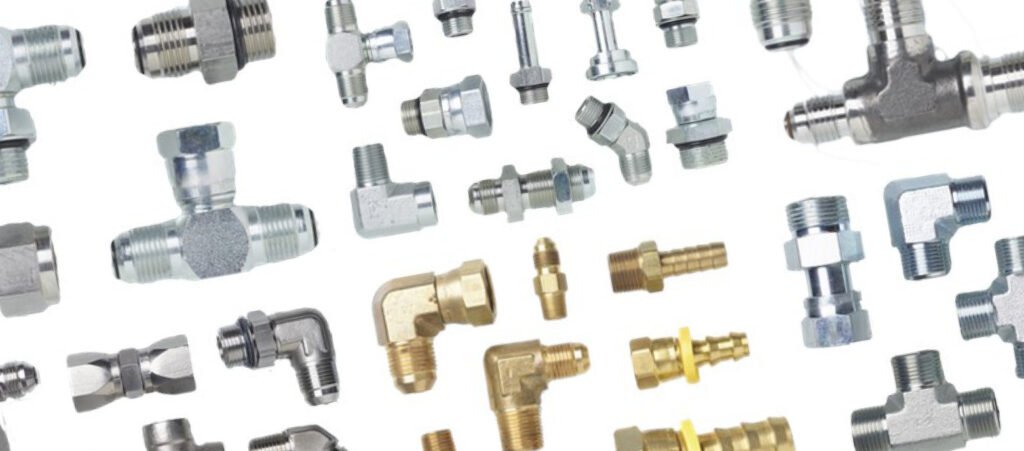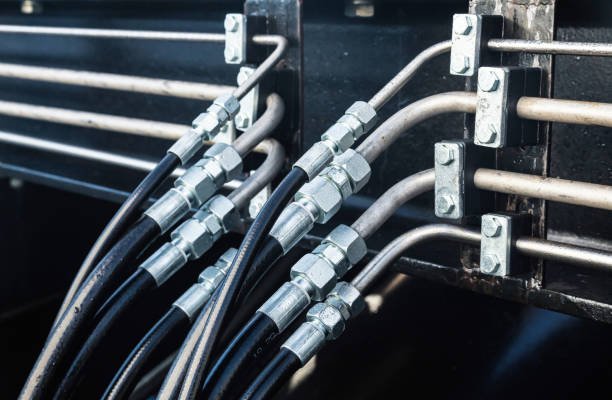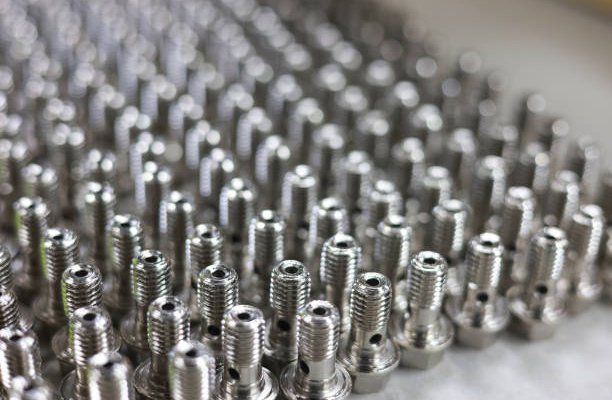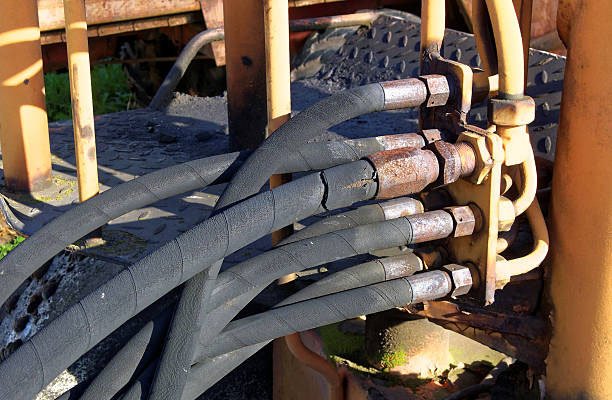Introduction
In the world of hydraulic systems, the choice of fittings can significantly impact performance, safety, and compatibility. Whether you’re engineering a high-pressure system for industrial machinery or maintaining a piece of agricultural equipment, selecting the correct hydraulic fitting standard—Metric, American (SAE), or British (BSP)—is critical. Each system comes with its own unique design, threading style, and application niche, making it essential to understand the distinctions between them.
This article provides an in-depth comparison of Metric, American, and British hydraulic fittings, breaking down their specifications, pros and cons, regional usage, and practical applications. By the end, you’ll be better equipped to choose the right fitting standard for your specific project or industry needs.
What Are Hydraulic Fittings?
Definition and Function
Hydraulic fittings are mechanical components used to connect hoses, pipes, and tubes in a hydraulic system. They enable the transmission of hydraulic fluid—usually oil—under high pressure, ensuring efficient power delivery and fluid control in various applications such as industrial automation, mobile equipment, aerospace, and marine systems.
Materials and Types

Hydraulic fittings are typically made from durable materials such as stainless steel, brass, or carbon steel to withstand high-pressure environments and prevent corrosion. Common types include:
- Compression fittings – rely on a ferrule to create a tight seal
- Crimp fittings – used with a crimping tool to secure hoses
- Threaded fittings – engage threads to form a leak-tight seal
- Quick-connect fittings – allow fast, tool-free connections
Each type plays a vital role depending on the hydraulic system’s pressure rating, fluid type, and environmental exposure.
Overview of International Standards
Global Adoption and Variations
Hydraulic fitting standards vary globally based on historical engineering practices and industrial requirements. For example:
- Metric – Predominantly used in Europe and Asia
- American (SAE/NPT) – Common in North America
- British (BSP) – Used in the UK and many Commonwealth nations
This variation means fittings from different systems are not directly interchangeable, which can lead to safety risks or equipment failure if mixed improperly.
Key Standard Organizations
Several global bodies define and regulate hydraulic fitting standards, including:
- ISO (International Organization for Standardization) – Governs most Metric fittings
- SAE (Society of Automotive Engineers) – Defines many American fitting types
- BSI (British Standards Institution) – Regulates BSP thread standards
Understanding these standards is fundamental for engineers, technicians, and procurement teams to ensure compatibility and system integrity.
Metric Hydraulic Fittings Explained
Origin and Standardization
Metric hydraulic fittings are standardized primarily under the International Organization for Standardization (ISO), and are widely used across Europe and Asia. The two main families of metric fittings include ISO 6149 and DIN 2353. These standards ensure uniformity in design, material strength, and sealing methods, making them highly reliable in global applications.
Common Types (DIN, ISO)
- DIN 2353: Compression-style fittings widely used in industrial automation and machinery
- ISO 6149: Threaded fittings with elastomeric seals designed for high-pressure systems
These fittings are frequently used in hydraulic systems due to their precision and tight sealing capabilities.
Thread Specifications and Sizes
Metric threads are measured in millimeters and follow a thread pitch format. For example, M14x1.5 means the thread has a 14 mm outer diameter and a 1.5 mm pitch. The threads are parallel and often paired with O-rings or cutting rings to ensure leak-free connections.
Advantages and Use Cases
- Standardized globally, especially in Europe and Asia
- Excellent sealing with O-rings or elastomeric inserts
- Highly precise manufacturing ensures tight tolerance
Metric fittings are ideal for use in industrial automation, machine tools, and European automotive applications.
American Hydraulic Fittings (SAE)
Origin and Standard Bodies (SAE, NPT)
American hydraulic fittings follow standards defined by the Society of Automotive Engineers (SAE) and the National Pipe Thread (NPT) specifications. These fittings dominate the North American market and are widely used in construction, mining, and transportation industries.
JIC, ORFS, and NPT Threads
- JIC (Joint Industry Council): 37-degree flare fittings, commonly used in high-pressure applications
- ORFS (O-Ring Face Seal): Flat-faced fittings with O-ring seals, excellent for zero-leak connections
- NPT (National Pipe Tapered): Threaded connections that seal through thread deformation
Each of these thread types offers different sealing strategies and is chosen based on system pressure and fluid type.
Application Areas
SAE fittings are widely adopted in:
- Construction and mining equipment
- Military and aerospace applications
- Heavy-duty trucks and mobile hydraulic systems
Benefits and Limitations
Benefits:
- Broad availability in North America
- Excellent high-pressure performance
- Multiple thread options for varied sealing needs
Limitations:
- Can be confusing due to multiple thread standards (JIC, NPT, ORFS)
- Tapered threads like NPT may require sealant and risk galling
British Hydraulic Fittings (BSP)
BSPP vs BSPT Thread Types
British Standard Pipe (BSP) threads come in two main variants:
- BSPP (British Standard Pipe Parallel): Threads are parallel; sealing usually achieved with washers or O-rings
- BSPT (British Standard Pipe Tapered): Threads are tapered; sealing occurs through thread deformation
These fittings are specified under the BS 5200 and ISO 1179 standards and are prevalent in the UK and many Commonwealth countries.
British Standard Origins
BSP fittings originated in the UK and were adopted across various regions during the British Empire’s industrial expansion. They remain dominant in sectors where British engineering practices persist.
Compatible Sealing Methods
Sealing in BSP systems depends on the thread type:
- BSPP: Typically sealed with bonded washers or O-rings
- BSPT: Achieves sealing through thread interference, often requiring thread sealant or PTFE tape
Industries That Use BSP
- Marine and offshore drilling systems
- British and Commonwealth-based manufacturing
- Older hydraulic equipment still in operation
BSP fittings are especially valuable in legacy systems and areas where British standards are institutionalized.
Major Differences Between Metric, American, and British Fittings
Thread Design and Geometry
The most obvious distinction among these three standards lies in their thread design:
- Metric: Parallel threads measured in millimeters, with thread pitch specified (e.g., M18x1.5)
- SAE (American): Includes both parallel (e.g., ORFS) and tapered (e.g., NPT) threads, usually measured in inches
- BSP (British): Available in both parallel (BSPP) and tapered (BSPT) styles, with thread size often labeled in inches but differing from American standards
Each thread design not only affects the connection method but also influences the sealing capability and risk of leaks under pressure.
Sealing Mechanisms
Each standard employs unique sealing strategies:
- Metric: Typically uses elastomeric seals or cutting rings for a tight, reliable seal
- SAE: Uses metal-to-metal flares (JIC), O-ring face seals (ORFS), or thread deformation (NPT) to achieve sealing
- BSP: BSPP uses bonded washers, while BSPT seals via thread interference and often needs PTFE tape
Pressure Ratings
SAE JIC and ORFS fittings are particularly popular in high-pressure applications due to their robust sealing, while BSP and Metric fittings offer solid performance but may vary in pressure handling based on sealing method and material.
Interchangeability and Compatibility Issues
None of these standards are directly interchangeable. Attempting to mate an NPT male with a BSPT female may result in cross-threading or leaks. Additionally, differences in thread angle (e.g., 55° for BSP vs. 60° for NPT) can render fittings incompatible even if they appear similar.
Identification and Measurement Tips
How to Identify Fittings by Eye
While experienced technicians can often identify fittings visually, even minor differences in thread pitch or diameter can cause mistakes. A trained eye looks for:
- Thread shape and spacing
- Presence of flared ends (JIC) or bonded washers (BSPP)
- Tapered vs. straight threading
When in doubt, always use measuring tools for accuracy.
Tools and Gauges Used
To correctly identify and measure threads, the following tools are recommended:
- Thread pitch gauges – Measure the distance between threads
- Calipers – For measuring outside and inside diameters
- Go/No-Go gauges – Confirm correct threading standards
Using these tools helps ensure compatibility and reduces risk during fitting replacement or repair.
Thread Pitch Charts and Sizing Techniques
Each standard comes with specific pitch charts that indicate thread sizes and their corresponding diameters. For instance:
- Metric: M12x1.5 (12 mm diameter, 1.5 mm thread pitch)
- SAE: 3/4-16 UNF (0.75-inch diameter, 16 threads per inch)
- BSP: 1/2\” BSPP (British pipe thread with parallel profile)
Having a reference chart on hand is vital for anyone regularly working with hydraulic fittings.
Compatibility Challenges and Solutions
Cross-Standard Adaptors
In systems involving international equipment, it’s common to encounter fittings from multiple standards. Cross-standard adaptors provide a viable solution, allowing you to connect, for instance, an SAE hose to a BSPP valve. However, adaptors should be chosen carefully to match pressure ratings and sealing needs.
Risks of Mixing Standards
Improperly mixing standards can result in:
- Leaks due to improper sealing geometry
- Thread damage from mismatched pitches or angles
- System failure under high-pressure conditions
Always verify compatibility before attempting a connection, even with adaptors.
Conversion Best Practices
If adapting is unavoidable, follow these best practices:
- Use manufacturer-approved adaptors with compatible sealing methods
- Avoid high-pressure zones for adapted connections when possible
- Label mixed-standard zones to prevent future confusion
Proper documentation and adherence to engineering specifications are essential when working with mixed fitting systems.
Regional Preferences and Market Trends
North America
In North America, SAE and NPT fittings are predominant, driven by local manufacturing standards and regulatory frameworks. American-made machinery, heavy-duty equipment, and military vehicles almost exclusively use SAE fittings, particularly JIC and ORFS types, for their robust sealing and high-pressure capabilities.
Europe
Europe heavily relies on Metric (DIN/ISO) fittings. German engineering, in particular, has influenced the widespread adoption of DIN 2353 compression fittings across industrial automation and manufacturing sectors. The uniformity and precision of Metric threads make them ideal for use in highly regulated industries.
Asia
Asia presents a mixed environment. While Metric fittings are standard in countries like Japan, South Korea, and China, many Asian manufacturers also produce equipment compatible with SAE and BSP threads for export to global markets. This dual-standard compatibility drives demand for high-quality adaptors and cross-reference charts.
Market Trends
- Increased standardization: Many global manufacturers are now offering multi-standard ports on equipment to cater to international customers.
- Digital thread identification: Apps and digital calipers with thread recognition features are helping engineers avoid errors in standard selection.
- Eco-driven design: New fittings aim to reduce fluid leakage and environmental impact, driving innovation across all standard types.
Application-Specific Considerations

Automotive
Modern automotive systems—particularly European brands—lean toward Metric fittings due to their compact design and tight tolerances. In contrast, American automotive and aftermarket parts often use JIC or NPT fittings, especially in custom or performance builds.
Aerospace
In aerospace applications, reliability is paramount. JIC and ORFS fittings are favored for their leak-proof connections under extreme pressure and temperature fluctuations. The aerospace industry also demands lightweight materials like titanium or aluminum, often available in SAE-standard fittings.
Agriculture and Heavy Machinery
Heavy equipment used in agriculture, forestry, and construction relies on fittings that can withstand vibration, debris exposure, and fluid contamination. Here, SAE and BSP fittings dominate, with BSPP used in older UK-based machinery and SAE JIC in modern, North American equipment.
Pros and Cons of Each Fitting Type
Metric Fittings
Pros:
- Globally standardized (DIN, ISO)
- High precision and repeatability
- Excellent sealing with O-rings and cutting rings
Cons:
- Limited availability in North America
- Requires specialized tools for measurement
American (SAE) Fittings
Pros:
- Widely available and supported in North America
- Flexible thread styles (JIC, ORFS, NPT)
- High pressure capability, especially ORFS
Cons:
- Multiple thread standards can cause confusion
- NPT threads require sealants and are prone to leakage over time
British (BSP) Fittings
Pros:
- Simple thread system with BSPP and BSPT options
- Strong legacy support in the UK and Commonwealth
- Cost-effective in certain applications
Cons:
- Limited compatibility with SAE/Metric systems
- May require bonded washers or tape for sealing
Safety and Compliance Factors
Leak Prevention
Properly selected and installed hydraulic fittings play a crucial role in preventing leaks. Even minor fluid leaks can lead to system failure, safety hazards, and environmental damage. Each fitting type has distinct sealing strategies, and their success hinges on proper torque, alignment, and thread compatibility.
Best practices include:
- Using fittings with built-in O-rings or bonded seals
- Avoiding over-tightening, which can deform threads and compromise seals
- Regular inspection and maintenance of connections
Compliance with Pressure Standards
Hydraulic systems are subject to strict regulatory compliance, especially in industries such as aerospace, construction, and oil & gas. Organizations like ISO, SAE, and BSI define pressure ratings, fatigue thresholds, and acceptable tolerances for each fitting type. Exceeding these thresholds can result in legal liability and operational failure.
Best Practices
To ensure both safety and compliance:
- Choose fittings rated for at least 125% of your system’s maximum operating pressure
- Follow manufacturer-recommended torque specs and installation guides
- Label fittings and adapters clearly to avoid mix-ups during maintenance
How to Choose the Right Standard for Your Project
Step-by-Step Selection Guide
Choosing the correct hydraulic fitting standard involves several technical and logistical considerations. Here’s a structured approach:
- Identify Equipment Origin: European systems typically use Metric, North American systems favor SAE, and UK/Commonwealth equipment often uses BSP.
- Check Thread Type: Use pitch gauges and calipers to confirm thread style and size.
- Assess Operating Pressure: Match the fitting to the system’s pressure and temperature range.
- Determine Seal Type: Decide whether you need metal-to-metal (JIC), elastomeric (ORFS), or bonded washer seals (BSPP).
- Consider Availability and Support: Choose fittings that are readily available and well-supported in your region or application.
Industry-Specific Recommendations
- Manufacturing: DIN Metric or ORFS for precision and reliability
- Heavy Equipment: SAE JIC or NPT due to rugged environments
- Marine: BSPP fittings are common in British-origin vessels
- Aerospace: ORFS and JIC for their high-pressure sealing
Future of Hydraulic Fitting Standards
Moves Toward Standard Unification?
With increasing globalization and cross-border equipment usage, there is growing momentum toward standard harmonization. Some manufacturers are already producing equipment with ports that support multiple thread types or come with interchangeable fittings.
Emerging Technologies in Fittings
Technological advancements are shaping the next generation of hydraulic fittings:
- Leak-free quick connect fittings designed for high-pressure environments
- Smart fittings with embedded sensors for condition monitoring
- Eco-seal materials to reduce environmental impact
Global Manufacturing Adaptation
To meet the needs of an international market, many OEMs are beginning to offer dual-standard fitting kits and integrated thread identification tools. This trend is expected to continue as industries demand more flexibility and compliance from their fluid power components.
Conclusion
Understanding the differences between Metric, American (SAE), and British (BSP) hydraulic fittings is crucial for designing, maintaining, or upgrading any hydraulic system. Each standard has evolved to meet the needs of specific regions and industries, offering unique advantages in terms of thread geometry, sealing technology, pressure ratings, and application versatility.
Whether you’re working on European automation equipment, North American heavy machinery, or British marine systems, choosing the right fitting can drastically improve system reliability, efficiency, and safety. Compatibility challenges can be mitigated through careful identification, appropriate adapters, and standardized selection procedures.
In a world moving toward globalized supply chains and technological integration, a deep knowledge of hydraulic fitting standards positions engineers, technicians, and procurement teams to make smarter, safer, and more cost-effective decisions.
FAQs
1. Can you mix Metric and BSP fittings?
While some Metric and BSP threads may appear similar, they are not interchangeable due to differences in thread angle, pitch, and sealing methods. Using adaptors is a safer and more effective solution if cross-standard connection is unavoidable.
2. Which is better: SAE or BSP?
Neither is universally better. SAE fittings excel in high-pressure applications and are popular in North America, while BSP fittings are common in the UK and preferred for legacy systems. The best choice depends on system requirements and regional compatibility.
3. How can I identify hydraulic thread types?
Use tools such as thread pitch gauges, calipers, and identification charts to determine the thread standard. Additionally, smartphone apps and digital calipers with database integration can aid accurate identification.
4. What is the difference between BSPT and NPT?
BSPT and NPT are both tapered threads, but they differ in thread angle—BSPT uses a 55° angle while NPT uses a 60° angle. Their threads are not compatible and attempting to fit them can cause leakage or damage.
5. Are adaptors safe for high-pressure applications?
Yes, if used correctly. Adaptors designed for high-pressure systems and made from appropriate materials can safely connect different fitting standards. Always ensure the adaptor’s pressure rating matches or exceeds your system’s requirements.





